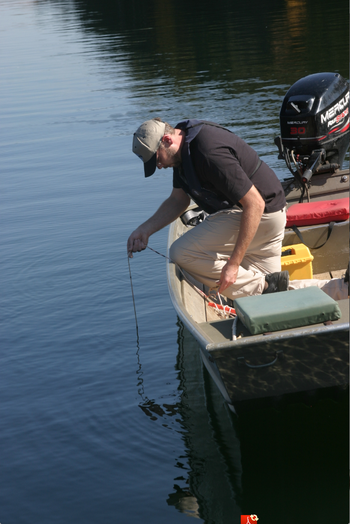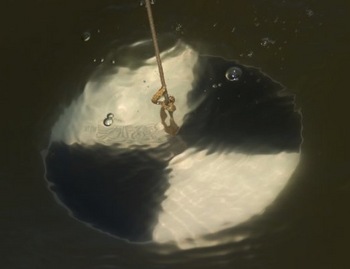Citizen scientists provide clarity for lake researchers’ big questions
A massive new study of water clarity trends in Midwestern lakes is sure to make some waves in scientific circles.
The study involved nearly a quarter of a million observations in 3,251 lakes spread across eight states, and data dating back seven decades. But it’s where that data came from that’s truly noteworthy. For the report, published online April 30 in the journal PLOS ONE, researchers turned exclusively to citizen scientists.
Each and every observation came from a lakefront homeowner, boater, angler or other interested member of the public wanting to know a little more about what’s going on in “their” lake.

Citizen scientist Tim Plude monitors the Secchi depth of Lake Tomahawk in Wisconsin’s Oneida County.
Photo: Laura Herman, Wisconsin DNR
More and more, ecologists are looking at big picture issues, like how changes in land use or the climate affect ecosystems at a state, national, or even continental scale, says Noah Lottig, a co-author of the study. Lottig, a scientist at the University of Wisconsin–Madison’s Trout Lake Station, a research facility run by the Center for Limnology, says there aren’t enough scientists in the world to collect data for these projects but, thanks to citizen scientists, “there’s a lot of information out there and, really, citizen data has been underutilized.”
In an attempt to start capitalizing on citizen-generated data, Lottig and a team of freshwater scientists from across the U.S. combed through state agency records and online databases full of water clarity measurements taken by nonscientists using a circular, plate-sized instrument called a Secchi disk. Used in aquatic sciences since the mid 1800s, Secchi disks hang from a rope and are lowered into the water until their distinct black and white pattern disappears from view, a distance that marks the “Secchi depth.” Lake associations and other citizen groups have used the disks for decades to document conditions on their respective waters.
Previous studies have shown that citizen Secchi readings are nearly as accurate as professional scientists’ measurements, says Lottig. With a dataset covering more than 3,000 lakes and stretching back to the late 1930s, his team decided to ask questions about large-scale and long-term change.

The plate-sized instrument called a Secchi disk is lowered into the water until its distinct pattern disappears from view.
Photo: Integration and Application Network
The Clean Water Act made a perfect candidate. Signed into law in 1972, the act set water quality goals for all U.S. waters. Thanks to the data collected by citizen scientists, Lottig’s team had water clarity measurements for decades both before and after the act came into effect. Somewhere in that data, they reasoned, they might detect a landscape-scale shift over time to clearer (often an indicator of cleaner) water.
What the authors found was that, on an individual scale, some lakes were getting clearer while others were not. However, says Lottig, combining all that data together indicates that there is a slightly increasing trend in water clarity at a regional scale. “Unfortunately,” he says, “the data don’t exist to explain those patterns.” Lottig hopes efforts like the “Cross-Scale Interaction” or “CSI Limnology” project, an international team of scientists that he’s a part of, can collect global data on things like water chemistry and aquatic biology that will add context to the data generated by citizens.
Though the citizen scientist dataset limited his team’s ability to explain the patterns they observed, Lottig says it suggests that such information can play a role in shaping future research — a possibility that has some scientific organizations taking notice.
Noah Lottig
“This study highlights the research opportunities that are possible using data collected by citizens engaged in making important environmental measurements,” says Elizabeth Blood, program director in the National Science Foundation’s Directorate for Biological Sciences, which funded the work. “Their efforts provide scientists with data at space and time scales not available by any other means.”
For Ken Fiske, it’s an effort that’s well been worth it. In 1985, Fiske saw a call for volunteers for a new Wisconsin citizen lake-monitoring program. Fiske, who had recently bought property on the shoreline of Lake Adelaide in northern Wisconsin, didn’t hesitate to sign up.
“My interest, initially, was in finding out what the quality of water in Lake Adelaide was and seeing what we could do to maintain it,” he says. “And if anything started to get out of whack, we could identify it very quickly.”
For the next several years, Fiske took a monthly five-hour drive up north to take measurements. Eventually, he got some neighbors to help. Nearly thirty years later, they are still going strong.
“It’s a cooperative thing and that’s what makes it work and we’ve been doing it long enough that it makes the results meaningful,” he says.
That meaning goes beyond the landowners around Lake Adelaide. All over the country, folks like Fiske have been peering into lakes for decades, collecting data on water clarity, temperature and more. And now, professional scientists are harnessing their efforts to try to answer some of the biggest questions on Earth.



